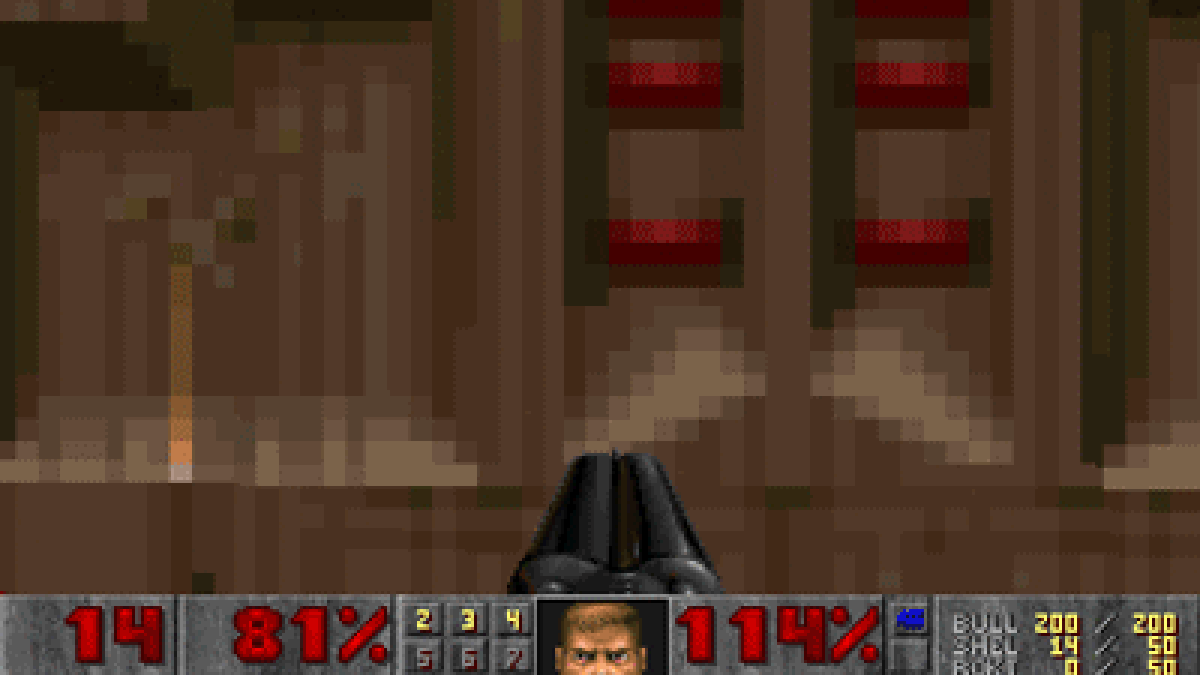I'm playing WRATH: Aeon of Ruin, and I recently played AMID EVIL: The Black Labyrinth. I've also just played Zortch, which was fantastic. I'm having fun with all these, but there's something about all these games - DUSK, Nightmare Reaper, Dread Templar, Project Warlock, and the like.
They have no stories, or coherent settings, or clear visual themes at all. Why is this? If you look at many actual 90s FPS games, they tend to have very clear plot hooks. They also have vivid settings with strong premises, a firm sense of place, and a bold sense of mood and tone:
Doom - Hell invades Phobos, and the protagonist is forced into a battle for survival which leads him through Phobos base (which has striking, clear visuals), Deimos base (which is merging with Hell, resulting in some cool aesthetics), and then Hell itself.
Heretic - the protagonist's race is the victim of persecution and genocide, and he becomes a lone hooded figure, driven by vengeance, stalking through the ruins of a dead world, hunted every step of the way by sinister shadowy figures who worship the creature which obliterated his people. Also has an undersea base with insanely cool visuals.
System Shock - protagonist is trapped aboard a space station and essentially forced into a high-speed chess game against a rogue AI, who is turning the station itself against him. Has many audio logs to give context and characterisation and further the story.
Blood - after being killed by his own cult, a man returns to life and takes vengeance on the cult to rescue his abducted beloved. Admittedly, Blood is very surreal with not much story and not much of what happens makes sense, but at least it has a very strong sense of place and visual style (1920s occult horror). Protagonist is very memorable and very vocal.
Outlaws - a simple Western story of rescue and vengeance, presented with really cool cartoon cutscenes.
Unreal - a prison ship crashes into a strange planet which is being invaded by a militatistic alien empire, and one of the prisoners escapes and makes her way across the surface, inadvertently fulfiling an alien religious prophecy and triggering an uprising in the process. You can learn a lot about the Nali from their architecture and art.
Half-Life - a man goes to work and has it all go horribly wrong. Aliens are all well thought out and have clear places in the Xen ecosystem, and Black Mesa itself is designed as an exaggerated interpretation of a real, believable location, with areas that have clear practical uses other than being battle arenas.
Meanwhile, with the likes of Amid Evil and WRATH and Prodeus and Project Warlock and DUSK, we have... a nameless hero fighting endless waves of surreal enemies in surreal environments for no clear reason. What's the big idea here? Even as early as Heretic and System Shock, actual retro FPS games were trying very hard to create a sense of verisimilitude, trying to create semi-plausible environments and evoke the feeling of fantasy and science fiction novels. There were even games like 1995's "Killing Time" that went full-on multimedia in an attempt to include more story. Why is the template for modern boomer shooters just surreal vomit with enemies who don't resemble anything, barely-there protagonists who have no presence in the game, and plots that are deliberately nonexistent?
Of course, the 90s shooter that most fits that description is Quake, which is surreal and has enemies that don't look like anything and locations that are deliberately nonsensical... but maybe not every fucking game should be Quake, especially when nobody seems capable of replicating Quake's sense of eerieness.
I really believe this is a big reason that many of these games fail to land with a lot of people, and why they're consistently viewed as worse than the games they're inspired by. AMID EVIL was fun, but you forget it five seconds after playing, because unlike Heretic and Hexen which it takes inspiration from, it doesn't have any kind of mood or story or concept that sticks in your mind.
I think you covered everything already in the original post, but I'll put a few thoughts down, having completed a couple of boomer shooters recently:
Story is one element that is missing from a lot of boomer shooter revival games, but I think there is more that is missing. To get the full Doom experience, let's say. For one thing, Doom, as noted elsewhere, is a pretty interesting explorefag game. Arguably, thanks to keys, it's an adventure game, even a kind of dungeon crawler. So some modern boomer shooters are missing that element, just throwing waves of enemies at you when exploring Doom or Dark Forces or Heretic's levels, at leisure, was a big part of the appeal.
Enemies are not that abundant either, and don't come back, so you feel you are cleaning the world of evil, one encounter at a time. It's not a million miles away from Wizardry-descended RPGs, or survival horror type adventure games.
Next I guess in terms of story, an adventure game is naturally geared toward environmental storytelling, since if they want to be interesting, they place their switches and keys in places that are suggestive of some purpose. For example Dark Forces having keycards on certain important-looking officers, switches inside control rooms, secret buttons behind desks, lonely desolate military outposts on far-flung planets, and things like the Death Star plans in a sort of high security containment area.




Why is there a wire-frame readout of the mysterious "Death Star" planet killer weapon in this facility? Why are the Death Star's plans behind a reinforced blast shield? Are those Stormtroopers and that alien mercenary using a urinal? Observe the burnt corpses of this planet's inhabitants after a Dark Trooper raid. Likewise say Quake II, not the greatest example of a boomer shooter by any means, tries to suggest that each factory, coolant system for a reactor, train loaded with energy supplies, or giant defence gun is there as part of a larger comprehensable picture.



Looking beyond shooters, a lot of franchises around then, were seemingly quite "happy go lucky" about their story, throwing rule-of-cool influences around, but always put some thought into how they could plausibly fit those concepts together, how they would function. On the surface of it, you would have a hard time justifying the "fanwank" concept of say a Viking fighting cyborgs or xenomorphs in space. However, with the right judicious choice of fictional conceits, you can make it work. So you could have Viking Space Wolves existing side-by-side with Renaissance Warrior Vampires, depending on your willingness to participate in the required few fictional conceits, and the skill of the developer in justifying it. Maybe the space viking colony was kidnapped from Norway to mine ore by an alien empire? Maybe vikings are all that survived of a human race that was destroyed in the 9th century?



Of course the less said about characterisation, the better, as the action is shown, not told, and the setting is the main character. It's also based in boy's spur-of-the-moment play. When kids imagine themselves in Indiana Jones, they are not imagining a 10 minute conversation scene generally. They are imagining their ass being chased by a boulder, or barely lifting a sea plane off a lake as heavy machine guns zone in. They are jumping around their bedroom imagining they barely made it across a deadly pitfall. Imagining for a second how, if you had the skill and face a huge threatening cyborg spider, you would quickly try to destroy it's legs with a power axe, and your childhood self would be rolling around dodging imagined death blows from razor-sharp legs. It's why anything, even say Ion Fury or Supplice's female protagonists, that suggests surrender to narratives, waifu inserts, is deeply suspicious. Maybe DEI forced it upon them, but equally likely the studio simply cannot divorce modern obsession with games being novels or telenovelas away from their concepts and art. The fact is women don't 'play' the way men do, they imagine social scenarios, don't love to imagine lifting their biplane off at the last moment, or barely making a jump across a fatal pitfall. The absense of Doomguy or Kyle Katarn or Corvus or Bitterman type protagonists is suspicious. Doom (2016) or Warhammer 40,000: Boltgun is in many ways the more traditional modern boomer shooter.





Fictional settings used to think in terms of scale. They used to think things through. They were interested in what happens when a conceptual sci-fi goes big. So if two human countries, at mere 1940s technology levels, can fling 20 million soldiers at each other in WW2, thought geeks, how much more should two entire planets be able to muster, or two leagues of planets? What about a planet riddled with bunkers, surface-mounted defence guns, orbital battlestations, etc? What would an utterly ruthless, focused organisation like say H.Y.D.R.A. actually build, if it had the resources? Submersible aircraft carriers, and flying-wing strategic bombers? What if a society had an utter pragmatic, unsentimental commitment to the enhancement of their soldiers into cyborgs, like the Strogg?
They say that good science fiction keeps the number of "fictional conceits" to a minimum, so that the audience doesn't have to swallow a lot during their suspension of disbelief. Say in Star Trek, you just have 1). FTL propulsion, 2). FTL communication and 3). teleportation. The rest is largely within current scientific contraints. The Strogg just have the conceit that 1). they can replace massive amounts of flesh with cyborg componenents without the problem of tissue rejection.
Sadly, one of the major developments since the days of classic boomer shooters, has been the acceptance of nano-technology as a major part of science fiction, so that some people tend to treat this speculative technology as an ill-defined magic power, unclear in it's limits, like a 'magic crystal', where something like Strogg cyborgs were a specific fictional conceit.




























